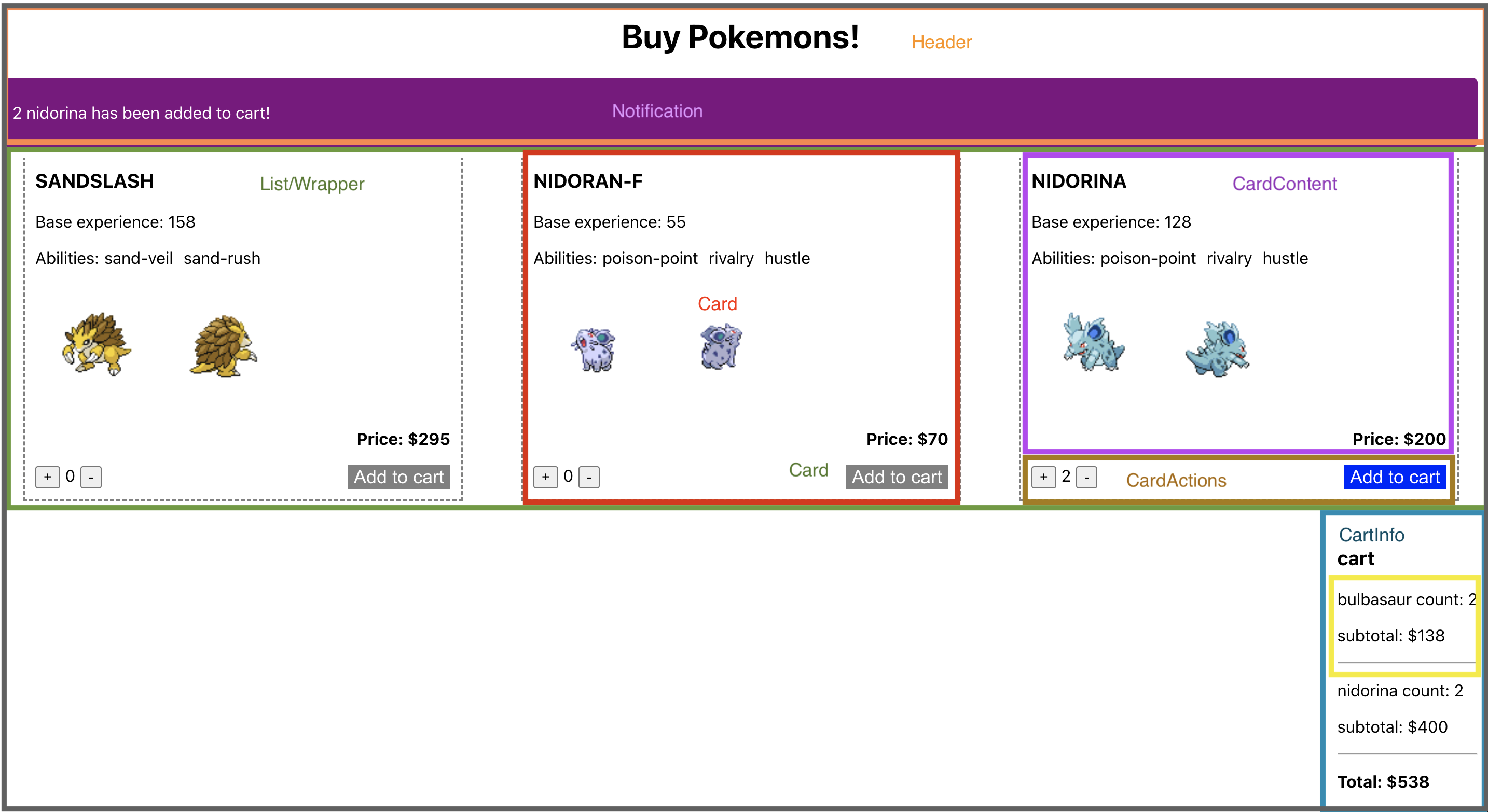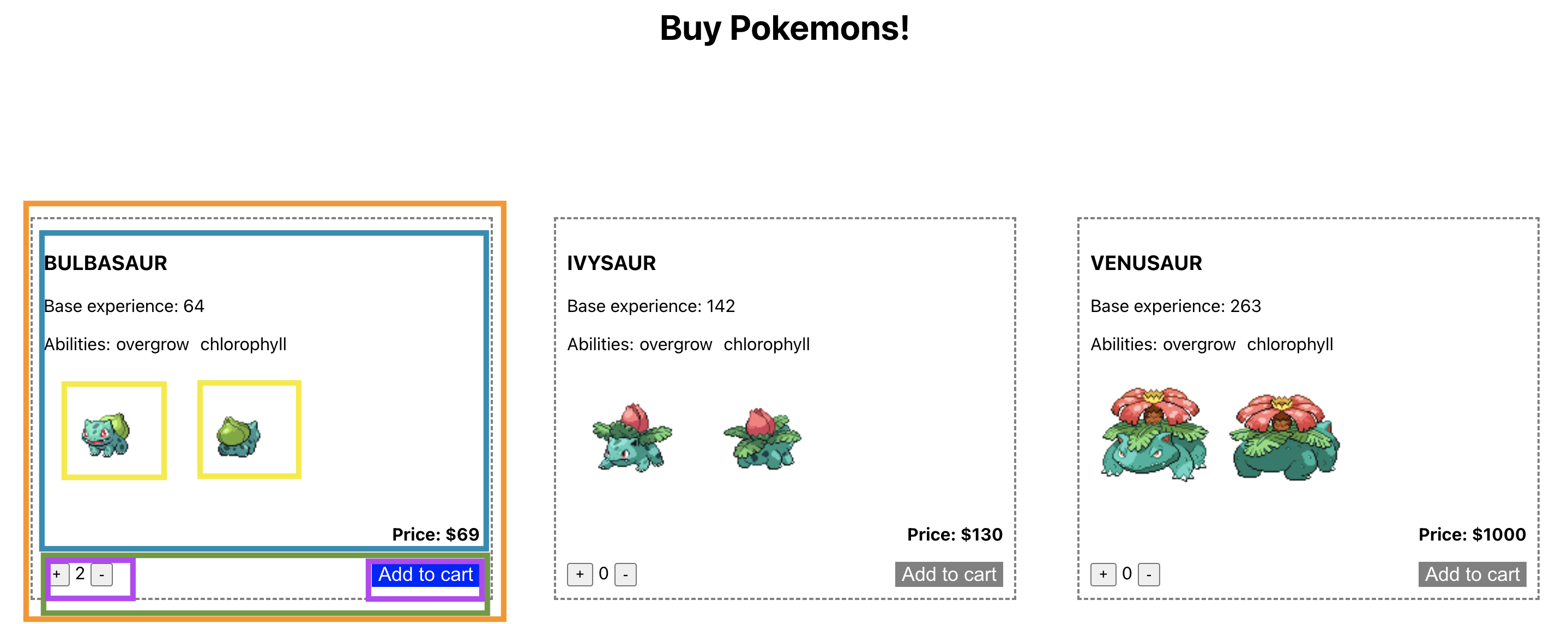webpack
- bundler: 將你的 js, css 等檔案 Bundle 變成單一的檔案
- loaders, css-loader, style loader
- 在 JavaScript 檔案中 require 一個 css 檔案。你可以 require 其他不只是 JavaScript 的檔案
- 如果你 require 的檔案結尾是 .css,然會我們會使用 style 和 css loader,將 CSS 加入到 bundle
- plugin , minify bundles
- 你可以透過
UglifyJsPluginplugin minify 你的 bundle 檔案來做改善
- 你可以透過
- webpack 自帶了方便的 webpack-dev-server, 實際在瀏覽器看到我們的網站
ref
babel
es6, es7 → es5
letconst- Arrow Functions
const x = (x, y) => x * y; - Spread (...) Operator
const cars1 = ["Saab", "Volvo", ..."BMW"]; const cars2 = ["Fiat", "Toyota"]; const combined = [cars1, ...cars2]; - class
class ClassName { constructor() { ... } }
yarn eject
- 使用這個指令後會將原本封裝在 CRA 的一些配置檔案都集中呈現在根目錄的 config 資料夾,就可以從這邊去調整 webpack。
- 看一下
package.json - 看一下
configfolder
yarn add styled-components
- 看一下
package.json - 看一下
node_modules
上工啦,今天來點寶可夢
- 先看一下成品
- 到
nlp_web/lab/pokemons底下git pull origin pokemon_version3_cartgit checkout pokemon_version3_cartyarn start
- 到
上工啦,今天來點寶可夢
- features
- 寶可夢卡片購買列表
- 用
fetch來抓 API data
- 用
- 寶可夢卡片互動
- count button
- Add to cart
- 點擊 add to count btn 會出現 alert
- 購買清單
- 點擊 add to count btn, cart 內有資料會出現購買清單
- 寶可夢卡片購買列表
note: version3
上工啦,今天來點寶可夢, different versions
- version1: simple version ;
git pull origin main - version2: add custom hook
useFetch;git pull origin pokemon_version2_custom_hook - version3: add cart info;
git pull origin pokemon_version3_cart
Note: slides 到 main branch 看最新的
Note: 切 branches demo 用,之後會把 brances 刪掉, nlp_web/lab/pokemons 只留 final version pokemon_version3_cart
React
React, DOM element vs. React element vs. React components
DOM element
DOM 將一份 HTML 文件看作是一個樹狀結構的物件,讓我們可以方便直觀的存取樹中的節點 (node) 來改變其結構、樣式 (CSS) 或內容等
React element
- 與瀏覽器的 DOM element 不同,React element 是單純的 object,而且很容易被建立。React DOM 負責更新 DOM 來符合 React element。
- An element describes what you want to see on the screen.
const root = ReactDOM.createRoot(
document.getElementById('root')
);
const element = <h1>Hello, world</h1>; // react element
root.render(element);
React component
- 概念上來說,component 就像是 JavaScript 的 function,它接收任意的參數(稱之為「props」)並且回傳描述畫面的 React element。
- 定義 component 最簡單的方法即是撰寫一個 Javascript function
function Welcome(props) { return <h1>Hello, {props.name}</h1>; }
React component
你也可以使用 ES6 Class 來定義 component, 上述兩種 component 在 React 中是同等的。
function Welcome(props) {
return <h1>Hello, {props.name}</h1>;
}
class Welcome extends React.Component {
render() {
return <h1>Hello, {this.props.name}</h1>;
}
}
React, render
<div id="root"></div>
- 使用 React 建立應用程式時,通常會有一個單一的 root DOM node。所有在內的 element 都會透過 React DOM 做管理。
- The root can be used to render a React element into the DOM with render:
const root = ReactDOM.createRoot( document.getElementById('root') ); const element = <h1>Hello, world</h1>; root.render(element);
React, render
- 看一下 root
<div id="root" />
note: version1
React, 切分 components
Component 使你可以將 UI 拆分成獨立且可複用的程式碼,並且專注於各別程式碼的思考。
以經驗來說
- 如果一個 UI 中有一部分會被重複使用很多次(Card、Button、Alert)
- 或者它足夠複雜(App、CardContent、CardActions),則可以將它提取到獨立的 component。
note: version1


React, JSX
什麼是 JSX
-
是一個 JavaScript 的語法擴充。透過這個語法來描述使用者介面的外觀
-
執行 JSX 會產生 React「element」。
-
JSX 允許你使用 JavaScript 所有的功能。
const element = <h1>你好,世界!</h1>; 在 JSX 中嵌入 Expression
const name = 'Josh Perez'; const element = <h1>Hello, {name}</h1>;
在 JSX 中嵌入 Expression
function formatName(user) {
return user.firstName+ ' ' + user.lastName;
}
const user = {
firstName: 'Harper',
lastName: 'Perez'
};
const element = (
<h1>
Hello, {formatName(user)}!
</h1>
);
JSX
- 透過這個語法來描述使用者介面的外觀, JSX 表示物件, 這種物件被稱呼為「React element」。你可以想像他們描述的是你想要在螢幕上看到的東西,React 會讀取這些物件並用這些描述來產生 DOM 並保持他們在最新狀態。
為什麼要使用 JSX
- 大部分人覺得在 JavaScript 程式碼中撰寫使用者介面的同時,這是一個很好的視覺輔助。
- 這也允許 React 顯示更有用的錯誤及警告訊息。
- React 並不要求使用 JSX
來看下程式碼
- 看下 components 如何拆分
- 看下
sumPricesin JSX
note: version3
React, props vs. state
- props (short for “properties”) and state are both plain JavaScript objects.
- While both hold information that influences the output of render, they are different in one important way
- props get passed to the component (similar to function parameters)
- whereas state is managed within the component (similar to variables declared within a function).
note: version1 props: handleAddToCart, pokemonUrl
React, hook
為什麼要使用 hook
- Hook 讓你不需要改變 component 階層就能重用 stateful 的邏輯。
- 你很可能會發現一個 component 的「包裝地獄」,被 provider、consumer、higher-order component、render props 以及其他抽象給層層圍繞。 → React 需要一個更好的 primitive 來共用 stateful 邏輯。
- 使用 Hook,你可以從 component 抽取 stateful 的邏輯,如此一來它就可以獨立地被測試和重複使用。
為什麼要使用 hook
- hook 讓你把一個 component 拆分成更小的 function,這基於什麼部分是相關的(像是設置一個 subscription 或是抓取資料,而不是強制基於 lifecycle 方法來分拆。
React, hook
- 什麼是 Hook?
- Hook 是一個讓你可以使用 React 各項功能的特殊 function。
- 什麼時候該使用 Hook?
- 以前當你寫一個 function component 需要增加一些 state 時,你必須轉換成 class。現在你可以直接在 function component 中使用 Hook。
class component
class Example extends React.Component {
constructor(props) {
super(props);
this.state = {
count: 0
};
}
function component
import React, { useState } from 'react';
function Example() {
// 宣告一個新的 state 變數,我們稱作為「count」。
const [count, setCount] = useState(0);
常用的 hook - useState
useState 是一個讓你增加 React state 到 function component 的 Hook。
import React, { useState } from 'react';
function Example() {
// 我們呼叫 useState Hook 宣告了一個新的 state 變數。並回傳了一對由我們命名的值。我們將代表點擊數的變數命名為 count
// setState -> 更新 state 的 function
const [count, setCount] = useState(0);
return (
<div>
<p>You clicked {count} times</p>
{/** 當使用者點擊,我們就呼叫 setCount 並傳入新的值。然後 React 就會 re-render Example component,並傳入新的 count 值。 */}
<button onClick={() => setCount(count + 1)}>
Click me
</button>
</div>
);
}
note: version1, state: loading, error, pokemons, count
常用的 hook - useEffect
side effect 在這裡做
- 資料 fetch
- 設定 subscription
- 或手動改變 React component 中的 DOM 都是 side effect (或簡稱「effect」)
常用的 hook - useEffect
useEffect 有什麼作用? 透過使用這個 Hook,你告訴 React 你的 component 需要在 render 後做一些事情。React 將記住你傳遞的 function(我們將其稱為「effect」),並在執行 DOM 更新之後呼叫它。
常用的 hook - useEffect
每次 render 後都會執行 useEffect 嗎? 是的!預設情況下,它在第一個 render 和隨後每一個更新之後執行。你可能會發現把 effect 想成發生在「render 之後」更為容易
來看下程式碼
- 看下打 API 的地方 (fetch)
- 再仔細看下互動的地方
note: version1
React, customize your hook
useFetch
hook 讓你不需要改變 component 階層就能重用 stateful 的邏輯
- loading
- error
- data
note: version2
callback function handleAddToCard
note: version3
cart
note: version3
lib: styled-components
yarn add styled-components
- 為了要以「元件」為開發單位,需要限制 CSS 的作用範圍,以元件為 scope,換句話說就是,要讓每個元件的 CSS 都是獨立的,這樣就可以避免元件之間的 CSS 互相影響覆蓋。另外,可以讓元件容易維護,也更容易重複使用
- 這段 CSS style 只會生效在這個元件內
- 不用擔心改了會不會影響其他元件
- 搬動元件時,不用額外搬動 CSS 檔
yarn add styled-components
- 提供了在 JavaScript 中直接撰寫 CSS 的介面,因為本體是 JavaScript,所以你可以做到:
- 在 JavaScript 裡面寫 CSS
- 在 JavaScript 裡面寫的 CSS 裡面寫 JavaScript
ref